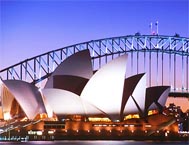Aboriginal counterpoint to the Sydney Opera House
 Sydney - Tourists asked what they want from a holiday in Australia usually bang on about native animals and wide open spaces, the Sydney Opera House and a glimpse into the life of the original inhabitants of the wide brown land.
Sydney - Tourists asked what they want from a holiday in Australia usually bang on about native animals and wide open spaces, the Sydney Opera House and a glimpse into the life of the original inhabitants of the wide brown land.
Tour operators have found an introduction to Aboriginal culture the hardest to provide.
More aborigines live in the cities than in the deserts and there are all sorts of cultural, political and social hurdles to meeting indigenous people.
It's possible, though.
Take the commuter train from the city centre to the seaside suburb of Cronulla. The journey takes less than an hour.
Board a boat for a five-hour cruise up the Port Hacking River and you can get a primer in Aboriginal culture, meet local elders and take part in a traditional smoking ceremony.
"Ngoon dyalgala niya, ngoon bamaraadbanga ni," is the welcome from Les Bursill, an anthropologist and our guide. His greeting means: "We embrace all of you, we open the door to all of you."
Bursill tells us his ancestors were the Dharawal, the traditional owners of the lands around the Port Hacking River.
Before the arrival of the colonists in 1788, the waterway was known to the locals as Djeebahn. It's a shallow bay and Bursill tells of a past where the Dharawal would hunt whales and collect food from the forest, hold big meetings called "corroborree," fish with hooks fashioned from shells and line made out of plaited palm.
On the one bank of the river is the desolate Royal National Park, the world's second oldest after Yellowstone in the United States. On the other bank are those lucky enough to live in houses overlooking the river - some even with their own jetties and boatsheds.
There is evidence aplenty that the Dharawal occupied this land. Bursill points out the piles of broken seashells on the banks - the litter of a life in which seafood was critical to survival.
The boat stops at a clearing and three Aboriginal warriors appear from among the gum trees. It's staged, of course, but the image of tribesmen with grass under their bare feet is a strong one.
Sometimes, the past that is invoked is not all that distant. Accompanying us on board is David Wright, a bushman nearing 60 who brings along samples of the fruit and herbs Aborigines used to treat aches and pains.
He's a dab hand with spears and that iconic weapon, the boomerang. Back in the 1960s, he tells us, initiation ceremonies in which the chests of young men were cut to create scarring were discouraged. Scarred children were turned away from school.
"But my father wanted me brought up in the traditional way," Wright recalled. "He didn't tell me what was happening but I was taken to a place and my front teeth were knocked out."
It's not something that would happen today, but the gnarled bushman doesn't hold a grudge. "Why? It's initiation. It's making a sign. It's like when you get married and you put on a wedding ring for life."
Uncle Max, one of the three warriors who appeared from the forest, laughs at the notion that his ancestors wore bright red loincloths. They would have been naked.
The women, though, would not always have been naked, Bursill tells us. For reasons of hygiene, they have fashioned the tail of a possum into a makeshift, sanitary towel.
Hiding nakedness is part of the give and take between white and black, part of finding an accommodation. It's like the smoking ceremony, in which eucalyptus leaves are scorched with fire to let off their pungent fumes. Uncle Max saves time by circumventing the tiresome kindling process with a box of matches.
We learn that the smoking ceremony, in which visitors are wafted with smoke, had a purpose. It was to kill any bugs that visitors from another tribe might have brought.
"You have the same," Wright said, adding, "You call it quarantine." (dpa)